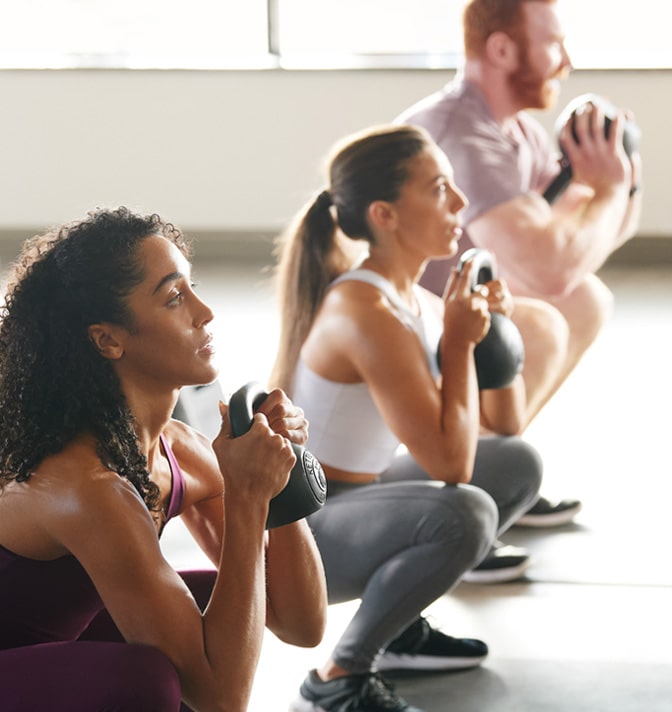I’ve been a member of Life Time for more than a decade, and there are so many classes I love, where each unique experience adds value to my health. As an Olympian and as a sprinter, Ultra Fit, one of Life Time’s signature group training formats, is quickly becoming my go-to. In fact, I love it so much I’ve recently started coaching and leading this program!
Although I’m not competing anymore, Ultra Fit allows me to tap into that same competitive mentality — in a fun and friendly way. It’s unique among exercise programs in that it brings sprint interval training (SIT) and strength and balance work together in one class — a winning combination with many health and performance benefits.
While strength and balance work are big parts of Ultra Fit, sprinting is the main event. And for many people, that’s the most challenging. But it doesn’t have to be. Other Life Time trainers and I can teach participants how to sprint both safely and effectively.
To help you gradually start introducing sprinting into your training, I designed this eight-week plan that’s intended for beginners, although it’s inspired by similar techniques I use with the athletes I train as a USA Olympic Coach.
The Plan
This sprint training program will help you develop proper speed mechanics. With sprinting, your goal is to apply maximal force to the ground with every step to move energy as efficiently as possible. Proper speed mechanics are essential to generating this force, as well as for avoiding injury, especially if you’re new to sprinting.
You’ll start each session with a warm-up to prepare your muscles and nervous system, followed by a gradual week-by-week increase of sprint duration to build up your sprinting capacity.
When sprinting, aim for an all-out effort, maintaining no lower than 80 to 85 percent of your maximum heart rate, which is about a seven on an intensity scale of one to 10. Gradually push your effort closer to 10 as you get more comfortable in your sprint execution.
Over time, this program can help you develop your coordination, balance, and stability, supporting the powerful unilateral positioning of sprinting. It can also support your foundational day-to-day health and fitness by increasing your anaerobic capacity and making your functional movements stronger and more powerful.
The Warm-Up
This seven-minute warm-up will help you develop proper sprint form:
| Movement | Movement Duration | Rest Duration | Repetitions |
| Tall Kneeling Hip Thrust | 30 seconds | 15 seconds | 2 |
| Body Walkout + Pushup | 30 seconds | 15 seconds | 2 |
| Toe and Heel Walks | 30 seconds, split | 15 seconds | 2 |
| A-March and A-Skip | 30 seconds | 15 seconds | 2 |
| Pogo Jumps | 30 seconds | 15 seconds | 2 |
| Short Sprints | 5 seconds | 15 seconds | 2 |
Tall Kneeling Hip Thrust
Activating your glutes and strengthening your neutral spine position (hips stacked directly under lumbar spine) help you generate maximal force with each step.
- Kneel on the floor with knees shoulder width apart and your feet together.
- Begin by sitting on your feet then lift your body up and out, thrusting your hips forward.
- Squeeze your glutes together at the end of the movement; be careful not to hyper-extend the lower back. You should feel your hips rotate directly underneath your lumbar spine.
Body Walkout + Pushup
Stimulating your core and stabilizer muscles is important for supporting proper sprint form. Adding the push-up activates your stretch reflex ability at your shoulder joints, which is important because the force from the upper body comes from the shoulder hinge, while driving the elbows back.
- Start with your feet hip width apart. Hinging from your hips, reach for the ground and place your palms on the floor in front of your feet.
- Slowly shift your weight onto your hands while bending your knees and beginning walking them forward until your body is in a straight line from your head to your heels, as if in a tall plank position (hands stacked below your shoulders).
- Perform a pushup, keeping your core rigid and engaged, then push back on your hands while bending your knees, and walk back to the standing position.
- Squeeze your glutes to get into a neutral spine position.
Toe and Heel Walks
Toe and heel walks improve balance, address ankle stiffness, and strengthen the stretch reflex and your ability to maintain hip height with each foot strike. In sprinting, the push off the ground does not happen until you get on the ball of your foot, so it’s important to strengthen your ability to directly land in this position when striking the ground.
- Raise your heels off the ground and walk forward on the balls of your feet for 15 seconds.
- Raise your toes off the ground and walk back on your heels, pulling your toes toward your shins. Do this for 15 seconds.
A-March and A-Skip
The A-March and A-Skip are dynamic drills that emphasize proper full-body sprint biomechanics. They are a great way to develop coordination and balance while promoting an efficient foot strike.
- Maintaining a tall posture with your hips square and chest high, shoulders down and back, lift onto the balls of your feet. March in place or forward remaining on the balls of your feet with your toes up (dorsiflex position), knees up (aim for hip height), and driving your elbows back while swinging your arms from your shoulders.
- Maintain ankle stiffness when landing, which will allow you to keep a consistent hip height and power with each step.
- When you feel conformable with the A-March, advance to the A-Skip, using the same approach but adding a ballistic element.
Pogo Jumps
Doing this plyometric exercise improves your muscle elasticity, further developing your stretch reflex and your ability to apply force efficiently from the ground through your hips. This is a great way for runners to practice being fast and/or explosive off the ground.
- Jump up and land on the bottom of the balls of your feet, keeping your toes up in a dorsiflex position (toes are pulled up toward your shin). Aim to spend minimal time on the ground with each landing – think fast and powerful. (Optional: For an extra challenge, add a jump rope.)
Short Sprints
Use these 5-second build-up sprints to gradually increase your speed to the pace you hope to achieve in your sprint intervals in that day’s work out.
- Run your sprints with proper sprint form: Your toes are up and the ball of your foot is exposed upon foot strike to keep ground contact minimal; your knees come as close to hip height as possible when you properly apply force down with each step; and you’re swinging your arms from your shoulders while driving your elbows back to help with full body force application. Keep your core rigid while sprinting to anchor the powerful push/pull motion of your legs.
The Sprint Interval Workout
Sprinting is a form of anaerobic exercise where your body requires more oxygen than your lungs can provide; it can only be maintained for very short periods — usually seconds. In order to be “sprinting,” you must perform at an intensity effort that approaches 100 percent of your maximum heart rate, an “all-out” effort.
To enter this anaerobic state when performing the sprints below, aim for an intensity level of at least seven on a scale of one to 10, where your breathing becomes uncomfortable and it’s difficult to talk. As your intensity increases week over week, you’ll notice your perceived rate of exertion will decrease as your anaerobic threshold increases.
| Workouts per Week | Sprints per Workout | Sprint Duration | Walking Rest Duration | |
| Week 1 | 2 | 4 | 10 seconds | 3 minutes |
| Week 2 | 2 | 4 | 10 seconds | 2 minutes |
| Week 3 | 2 | 4 | 15 seconds | 3 minutes |
| Week 4 | 2 | 4 | 15 seconds | 2 minutes |
| Week 5 | 2 | 4 | 20 seconds | 3 minutes |
| Week 6 | 2 | 4 | 20 seconds | 2 minutes |
| Week 7 | 2 | 4 | 25 seconds | 3 minutes |
| Week 8 | 2 | 4 | 25 seconds | 2 minutes |
Recovery Tip: Lactic acid is produced in your muscles during intense anaerobic exercises such as sprinting, which can lead to muscle pain, cramps, and fatigue. Sticking to longer recovery periods between sprints helps your muscles recover, reducing lactic acid build up and preventing injury. Always remember to take the time to cool down with static stretches or a short three-minute jog when you finish your workout.
Before starting any new fitness program, consult with your healthcare provider. Sprint interval training (SIT) and Ultra Fit may not be appropriate for people with certain health conditions.





